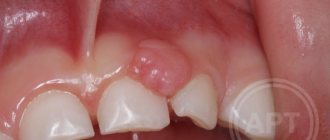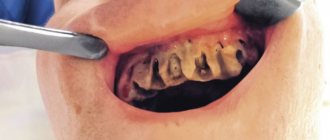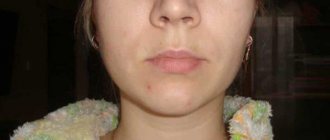Alveolar osteitis (alveolitis, fibrinolytic alveolitis, osteomyelitis, dry alveolus, thrombus infection, etc.) is an inflammation of the open area of the alveolar bone (alveolar process of the upper or lower jaw). It is a classic complication after surgery to remove a tooth(s). It usually occurs when, after surgery, a cavity or defect remains in the gum. This leads to the fact that the acidic environment of the oral cavity begins to affect bone tissue, causing alveolar osteitis.
A fragment remains after tooth extraction: why does this happen?
A tooth is an integral organ that consists of a crown and root parts. If a root or splinter remains after tooth extraction, it means the tooth has lost its integrity. This occurs due to mechanical stress during removal. Tooth destruction during extraction occurs for a number of reasons.
- Doctor's mistake.
Lack of doctor qualifications is a fairly common cause of complications. Incorrect tooth extraction technique can lead to the destruction of even a relatively strong tooth. - Poor condition of the tooth root.
If the root of the tooth remains in the gum, this is often due to the fact that the root part was in poor condition, so when you try to remove it, the tooth literally breaks into two parts. - When removing a tooth,
the neighboring one was hit, and a fragment from it fell into the socket. This happens quite rarely, but it still happens. This situation is also a consequence of incorrect extraction technique.
How is bone volume restored?
To restore the volume of bone tissue in a very thin area at the site of the dental alveolus, bone is split and the cavity is filled with bone tissue (an auto-, allo-, or synthetic graft is used). Then, after bone regeneration is complete, the implant itself can be installed. When it is necessary to increase the height of the bone, simultaneously with the implantation, bone tissue is increased with a special preparation that replaces it. A membrane coating is applied on top. The alveolar bone with various extension designs should heal and strengthen within 4–6 months, after which an artificial tooth (ceramic or metal-ceramic crown) can be installed.
To restore jaw bone tissue, an autogenous graft is used (bone is taken from the patient himself from another part of the jaw); allograft (donor bone is taken from another person) or synthetic materials that mimic bone (they contain calcium and phosphorus).
Symptoms
This complication has very pronounced symptoms.
- Pain.
Many people perceive pain as a standard consequence of tooth extraction. This is partly logical, but over time the pain does not stop and only gets stronger. This is a clear sign of a complication. - Swelling and inflammatory process.
A tooth fragment injures soft tissues, causing swelling and inflammation. The longer you delay treatment, the stronger the inflammation. - A characteristic coating in the area of the hole.
Appears at a later stage, when the body tries to fight the inflammatory process. - Pus and bad breath.
A late stage complication that requires immediate intervention.
Some more tips
If you have the opportunity to choose a clinic where you can have teeth removed, then it is best to give preference to the paid option, since the quality of the services provided there is higher than in free clinics. However, it is best to look for reviews of other people on the Internet about a particular clinic; if the clinic has experience in performing dental operations, then there should be reviews about it.
Regardless of how well your molars are removed, you run the risk that periosteum will appear days or months later. Most often, the removal of the periosteum occurs quickly and without particularly severe pain. If you do not want to remove the periosteum surgically, then talk to your doctor about the possibility of an alternative option. Most likely, your doctor will suggest that you buy a special dental cream, thanks to which the periosteum will come out on its own within a few days of use.
Complicating factors
The extraction procedure itself is ordinary and highly predictable, given the level of modern dentistry and the technological equipment of clinics. Nevertheless, even such manipulation has complications, especially if you take it lightly. It is worth taking into account that each clinical case is individual: if in one case tooth extraction is not very difficult, then in another the dental surgeon has to apply all his skills and use advanced technologies and equipment in treatment. It is no coincidence that the price lists of clinics include the item “Complicated tooth extraction”: you have to pay more for this service. Experts identify several factors that can lead to complications, including fragments in the socket.
- Wisdom teeth.
Because of their remoteness, default eights are quite difficult to remove. They often grow incorrectly or do not fully erupt, which increases the risk of complications during removal. - Retention.
A tooth that has not fully erupted, when only part of the crown is visible above the gum or is completely hidden in the soft tissues. - Dystopia.
The tooth erupts at the wrong degree and abuts its neighbors. - The tooth is severely damaged due to trauma.
In such a situation, when removed, it may crumble, and some of the fragments will remain in the hole.
Surgical removal of exostosis on the gums
The operation is performed by a dental surgeon. In many cases, local anesthesia is sufficient for pain relief. It is possible to use deep sedation or anesthesia, especially if there are many osteophytes and they are large.
Amputation of bone growths is carried out in stages:
- local or general anesthesia:
- antiseptic treatment of the oral cavity;
- gum incision to access the correction area;
- amputation of a lump with a chisel or laser;
- grinding with a drill until the bone is smooth;
- repeated antisepsis;
- suturing and bandaging.
The operation time depends on the clinical case. It can range from 40 minutes to 2 hours. When using local anesthesia, the patient can go home immediately after the bleeding stops.
What to do if the tooth is not completely removed?
If a piece of a tooth or part of a root remains after removal, and the doctor did not notice it, then sooner or later the symptoms described above will appear. What to do if a tooth is pulled out and a fragment remains? First of all, there is no need to panic. A regular x-ray can detect the presence of foreign bodies, including remaining fragments. In most cases, tooth removal does not take much time and is performed using standard surgical techniques. If the case is complex, an incision of the mucosa may be required. Today there are advanced surgical treatment techniques, such as laser surgery. Thanks to this, in difficult cases it is possible to reduce the invasiveness of the intervention. Be that as it may, for a qualified dentist, coping with the complication will not pose any great difficulties. The main thing is to contact him in time.
Many people are interested in whether the tooth root can come out on its own. If after removal part of the root remains in the gum, then you definitely shouldn’t count on it. Sometimes a tooth fragment may come out on its own, but there is no need to hope for this either. Moreover, you should not try to remove a tooth fragment from the socket yourself. You will most likely hurt yourself even more. If you notice remains of a tooth in the hole, go to the doctor immediately.
Peptides for bone tissue restoration in dentistry
There are peptide bioregulators that specifically stimulate the regeneration of jaw bone tissue and promote bone formation. They are also called odontotropic regulatory peptides. Peptides for bone tissue restoration in dentistry are used both for treatment and for preventive purposes. First, you must definitely visit a dentist and, on his advice, choose a drug - balm, capsules or toothpaste. For example, Revidont toothpaste contains three types of peptide complexes (A-3, A-4, A-6) and superoxide dismutase. The therapeutic effect of the paste includes strengthening the structure of teeth, normalizing microcirculation in the oral cavity, restoring bone tissue and having an anti-inflammatory effect.
Other situations
Sometimes after tooth extraction a phenomenon called ecostosis occurs. After tooth extraction, the edge of the gum settles, causing part of the bone to protrude to the surface. Many patients may mistake a piece of bone for a tooth fragment. Ecostosis can be easily eliminated using the usual grinding procedure, so there is practically nothing to worry about in this case. Sometimes part of the bone material may come out of the hole, which is replanted with the patient before implantation if the height and volume of the native bone is not enough. Sometimes small pieces of bone material may come out through the sutures, but this is also not considered a serious complication.
If, nevertheless, the patient postponed the start of implantation
And he put it off for a very long time. Returns to the doctor after a few years, for example. What regulations will be followed in this case for implant installation? Here, the moment of implantation also depends on the previous tooth extraction. The dentist must remove the tooth in such a way as not to damage the walls
bone tissue. That is, atraumatic:
You should always try to remove the tooth as carefully as possible. And if the tooth was removed with damage to the bone tissue, and the patient was not implanted immediately, then after two months the question of bone tissue augmentation will arise. What to say if the patient arrived even later? Of course, the question of bone restoration and bone grafting will arise.
How disadvantageous is it for a patient to delay dental implantation?
Research conducted in Russia by independent institutes shows that there is no increase in the number of implantations from year to year, despite the fact that the total number of dental services provided to the population is growing steadily every year. The most popular type of implantation is the implantation of the frontal group of teeth, that is, the front teeth. But in the area of the chewing group of teeth, patients are in no hurry to undergo implantation.
Are there medical reasons for postponing dental implants? Medical reasons for refusing to install a dental implant include general reasons:
(diabetes mellitus, hormonal changes, systemic lupus erythematosus, HIV infection, etc.) and
local
.
For local reasons related to the area of the mouth, at present there is practically no list that existed in Russia 15-20-25 years ago, when this area of dentistry had just begun to develop in the country. At that time, the widespread leadership was held by removable dentures, which had and still have a number of serious disadvantages. Yes, there were many local medical reasons, but progress and technology do not stand still. Therefore, now we can (even conditionally) talk about the general reasons for delayed dental implantation, which I mentioned above.
Removable prosthetics as a deterrent to implantation
Removable prosthetics, which prevents the increase in the number of requests for implantation, should probably be considered from the point of view of the economics of patient costs. Removable dentures are much cheaper than implantation followed by turnkey prosthetics. But removable dentures have a significant drawback - they do not prevent the resorption of bone tissue, and in some cases they increase the rate of resorption, with an increase in the pathological load on the temporomandibular joint (TMJ).
Therefore, in the long term, dental implants have a huge advantage
before removable prosthetics to preserve the patient’s bone tissue and, accordingly, the healthy state of all the patient’s maxillofacial system. As they say, “the miser pays,” but not twice, but several times more during his life with removable dentures.











